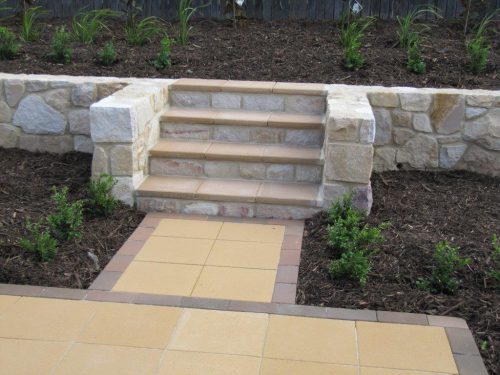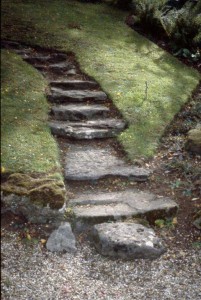
Often, when I am discussing a new garden, people immediately start giving me long plant lists.
But it’s not possible to start planting until hard structures and the layout of garden beds have been decided on.
The planting area will be reduced by lawns, an essential feature if you have small children. Then there’s the effect of play equipment, a garden shed or, maybe, a chook pen on further constraining the planting area.
Until the hard landscaping is in place, the planting area may be a quarter of the size planned for plants.
On sloping blocks, retaining walls and steps will almost certainly be needed. It’s important to get these details right as it can be expensive to change them later.


The tread of steps needs to be a minimum of 340mm or the width of a brick and a half. Each step or riser should be no higher than 180mm.
The photo of brick steps, above, illustrates all of these points. Also, I designed the steps with the wings retaining soil spread outwards. This gives the impression of outstretched arms saying: “Welcome to our home”. Often we use Bink’s concrete pavers, in this instance the sandstone finish, which fits in with most landscaping.
PATHS
Paths should always lead somewhere, linking the various elements of the garden, ie to the clothes line or the garden shed.
With small children, it’s an idea to connect the paths to form a circular track for tricycles etcetera. Make it at least one metre wide. As a garden matures, there is nothing worse than losing half the load off the wheelbarrow pushing it through the shrubbery.
It seems standard practice with builders, particularly on spec-built homes, to lay concrete paths right next to the home.
They may be practical but concrete paths are the most uninspiring. In some instances, they can be made more pleasing to the eye with clay pavers laid as a “header course” each side of the path. Header course is landscaper jargon for laying the pavers next to each other rather than end to end. For an existing narrow path this immediately increases the width by 460mm.
It’s always best to have a paved area for an outdoor table and chairs. A six-seater setting will require a paved area not less than three metres wide to allow for chairs to be pushed back without going into the garden. Once again, Bink’s concrete pavers, which are available in a variety of colours, offer an ideal size at 400mm x 400mm.
Jottings…
- Continue to apply snail and slug killer to strawberry beds.
- If there’s space, plant Kiwi fruit, which grow well in this climate.
- Check the use-by date on seed packets, it’s as important as when buying food.
- Clean dust off the leaves of indoor plants with a damp cloth. This prevents the plant breathing.
Who can be trusted?
In a world of spin and confusion, there’s never been a more important time to support independent journalism in Canberra.
If you trust our work online and want to enforce the power of independent voices, I invite you to make a small contribution.
Every dollar of support is invested back into our journalism to help keep citynews.com.au strong and free.
Thank you,
Ian Meikle, editor




Leave a Reply